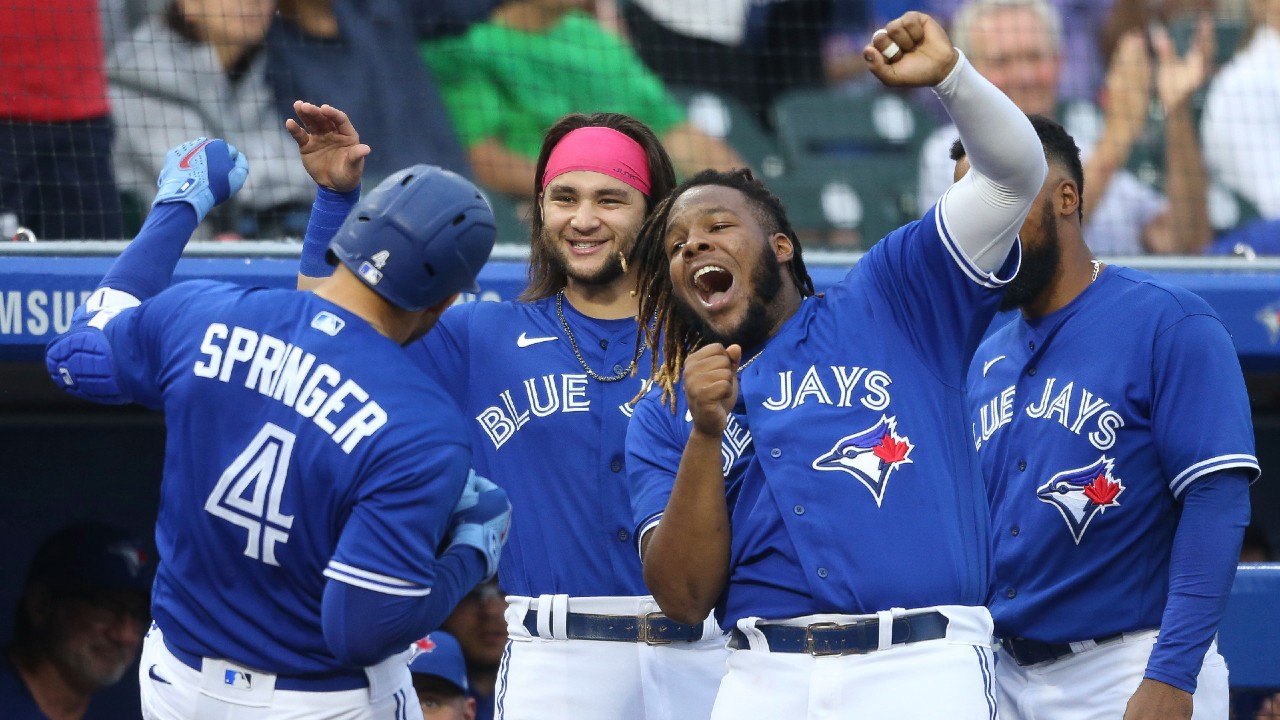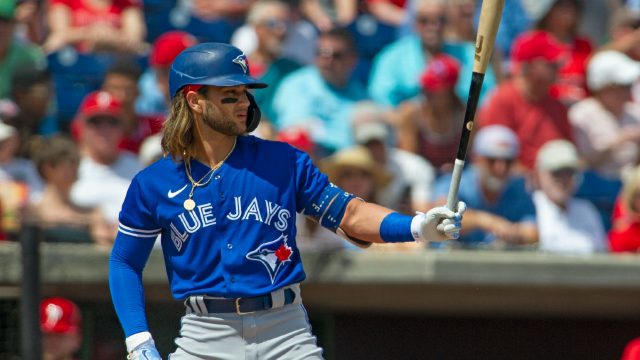DUNEDIN, Fla. — The Toronto Blue Jays will begin a significant renovation of Rogers Centre next off-season, overhauling the 33-year-old stadium’s lower bowl and concourses in a project that’s expected to be completed in time for the 2024 MLB season.
The highest priorities of the renovation will be modernizing Blue Jays player facilities, re-creating a similar environment to the one athletes enjoy at the club’s new player development complex in Dunedin, Fla., and improving the fan experience around the stadium.
“Create neighbourhoods, create a diversity of fan experience for different groups of our fan base and create some premium (seating) — because we have the third-least premium in all of Major League Baseball, especially in the lower bowl,” Blue Jays president and CEO Mark Shapiro said of the club’s plans. “The majority of the impact's going to be felt in the lower bowl and concourses. But we will touch every part of the interior of the stadium.”
The final cost of the privately funded project is not yet known, as planning, design and budgeting processes are ongoing. But the club anticipates revealing more complete plans for the renovation in May.
The club envisions completing around 30 per cent of the work next off-season, and the final 70 per cent in the winter of 2023-24. The club isn’t planning to change the dimensions or situation of Rogers Centre’s playing surface, with the renovation’s largest and most noticeable impact coming to the stadium’s lower bowl, which will be completely replaced. Rogers Centre’s exterior will remain mostly untouched.
The project is intended to buy the Blue Jays 10-15 years to envision a longer-term solution for the outdated building, which opened in 1989 and is MLB’s seventh-oldest stadium. Ultimately, the club will have to build a new ballpark — either on Rogers Centre’s current site or elsewhere in Toronto. And although the option of rebuilding within Rogers Centre’s footprint was considered in this round of planning, that idea quickly grew to a scale that proved unfeasible in the short-term future.
“What we learned is the magnitude of effort that it would take, in people and time and expertise and dollars, to plan the next-generation stadium, we didn't have in place,” Shapiro said. “That is going to take a lot of time and a lot of energy, and it's not going to be able to be a part-time job for three people in the organization. We're going to need to build a group to work on that effort and deal with it. So, that has not been done yet. The point is, let's get this renovation done and then start working.
“We'll still have a stadium issue. (The renovation) just gives us a good runway to deal with a very complex issue on a stadium. What does that look like if we stay where we are? What does that look like if we consider moving? That is extremely challenging. And this gives us 15 years without compromising fan experience and without compromising supporting our team, both with the right facilities and the right level of resources.”
The renovation will be the latest in a series of substantial capital investments from Blue Jays owner Rogers Communications on the heels of two pandemic years in which club revenues took a significant hit.
Due to governmental border restrictions, the Blue Jays have played 188 of 224 games over the last two seasons — just shy of 84 per cent — away from Toronto. And attendance has been restricted during the 36 games the club played at its true home — to 15,000 for 30 of those games and 30,000 for the remaining six — since the beginning of the 2020 season. The last time the Blue Jays had more than 30,000 people in attendance for a game at Rogers Centre was Aug. 14, 2019 — more than 30 months ago.
In the meantime, the club has spent considerably to not only shift its major-league operations to temporary homes in Dunedin, Fla., and Buffalo, N.Y., but to upgrade the minor-league ballparks hosting its relocated home games to an MLB standard. Its also spent substantially on payroll, signing George Springer to a six-year, $150-million free agent contract, Jose Berrios to a seven-year, $131-million extension and Kevin Gausman to a five-year, $110-million deal within the span of 11 months last year.
The Blue Jays aren’t opening their books any time soon, but you don’t need a look at them to assume the club’s expenses have greatly outpaced its revenues for some time. And the Blue Jays are set to run an estimated payroll north of $170 million in 2021, according to RosterResource, which would be the highest in the franchise’s history.
“It's certainly the highest since I've been here," Shapiro said. “That's probably just a byproduct of time and inflation and all those things and certainly the payrolls for the game are the highest in history. So, I think it's more of where we are in relation to other teams and things like that. But we're in a spot where we certainly feel well supported.
“I think the greater story about the support is not just the payroll this year — it's more the hundreds of millions of dollars we lost over the last couple of years and the ability to sustain the plan without any interruption,” he continued. “The continued commitment to infrastructure and resources — those are the things that are going to allow us to continue to be a contending team. The fact that we, basically, at times had no revenue, or very little revenue, and still had most of our expenses, and still were able to operate without interruption — we're incredibly grateful for the support during that time.”

And yet, those expenses are likely to continue to rise. Substantially so if the club intends to extend its tandem of young, homegrown stars: Bo Bichette and Vladimir Guerrero Jr. Each player is under club control for the next four seasons, which removes some urgency on the team’s part to lock them up long-term. But each player is approaching his mid-20s and continuing to improve as well, which ought to increase their productivity and, in turn, their potential earning power.
After a tough negotiation, Guerrero and the club settled on a $7.9-million 2022 salary to avoid arbitration in the 23-year-old’s first of four years of eligibility for the process. If he remains healthy and productive, Guerrero will have an opportunity to approach and even surpass record arbitration salaries. Meanwhile, Bichette recently indicated how resolute he intends to be in any future negotiations with the club by rejecting his latest pre-arbitration salary renewal offer, saying, “I understand that I am worth more — I know that I’m an outlier.”
Brass tacks: both players are positioned to earn considerable arbitration salaries. And there’s precedent to suggest a long-term extension for either ought to run nine figures and start with a three.
RosterResource estimates the Blue Jays already have nearly $120-million on the books for 2023 before considering a top-heavy arbitration class including Guerrero, Bichette and Teoscar Hernandez, who will be working off a $10.65-million platform. Add in any additional free agent spending to address inevitable roster deficiencies and the Blue Jays could quickly surpass this season’s record payroll spending.
Which isn’t out of the question, according to Shapiro. That’s where the team’s return to Toronto and Rogers Centre’s impending renovation come together. With one of the American League’s best rosters, the Blue Jays are positioned to win a lot of games and sell a lot of tickets in seasons to come. And once the renovations are complete, the organization will be able to extract more game-day revenue from the tens of thousands passing through their turnstiles 81 times a year.
Which is to say nothing of merchandise, concessions and advertising sales. Of additional revenue generated by the club’s broadcaster, Sportsnet, which is owned by Rogers Communications (the same company owns the team and this website). Of new and emerging revenue streams, such as a partnership with a sports betting company, which Shapiro says the club is close to finalizing.
After two years of severely depressed revenues, the franchise’s income taps are about to open back up in a very meaningful way. And that could beget even more investments in infrastructure and payroll than we’ve already seen.
“The team that we've got is going to win — and it's pretty clear what happens in Toronto when we win. And I'd like to think that there's even some things that, with the evolution of the city, and the incredible growth in the city, and the potential of winning for four or five years, that we don't even know what that could mean,” Shapiro said. “I think there's an opportunity for us to sustain much higher payrolls. Not in the top five — but certainly close to that.
“But that's going to be based on attendance and revenue at some point. It's not just do we need to spend to spend,” he continued. “I would say that the most important thing to ensure that we're competitively with those teams is spending the money that you don't see. Continuing to build out the resources that are essential to us executing and building a best-in-class organization.
“It's committing to nutritionists, committing to mental performance coaches, committing to analysts and programmers and data managers. It's committing to the dozens of people you don't see that are obsessively focused on bringing talent into the organization. We cannot slip up on that. We cannot lapse on that. We cannot feel content with where we are.”
Which is why the Rogers Centre renovation Shapiro announced Friday is about more than just a new lower bowl and improved concourses. It’s more than merely giving players better tools and facilities with to prepare, compete and recover; more than creating unique fan experiences for the paying customers who ultimately sustain the business.
It’s another layer in the long-term plan Shapiro initiated when he took over the organization in November 2015. It’s connected to the farm system that’s steadily been replenished through trades, drafts and the international market. To the complete overhaul of, and significant investment in, the organization’s approach to player development.
To the new complex in Dunedin; to the expansion of the club’s analytics department; to an ever-growing army of high-performance staff; to handing out four of the six largest contracts in franchise history over the last three years.
It's all working in concert to turn the Blue Jays organization into the “juggernaut” Shapiro has said it could one day be. A developmental factory that supplies its roster both from within with emergent young talent and outside with established veteran free agents. A place where premium players such as George Springer and Kevin Gausman want to play. A sustainable winner, the hottest ticket in town, watched by millions night after night. A powerhouse that generates copious revenue, operates as one of the league’s freest spenders and, ideally, raises multiple championship banners along the way.
That’s the vision Shapiro pitched seven years ago and, although a global pandemic threw a stick in the spokes momentarily, it’s getting closer and closer to becoming a reality. Much of it has already been in place for years. A renovated stadium’s next. Now, it’s time to chase the biggest piece of them all.
“I hope we have one or two world championship trophies in the case — that’s what I hope we look like,” Shapiro said when asked where he’d like the organization to be when the Rogers Centre renovation is complete in 2024. “That we’re selling out games. That our fan base is energized throughout the entire country. And that we’ve got a couple trophies.”




